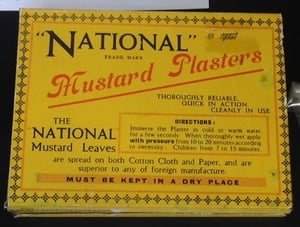
I have fond and vivid memories of my grandmother coming over when we were ill. She was either making her mullein, flaxseed and whiskey cough syrup, some herbal mixture or treating my mom with her famous mustard plasters for pneumonia. My mother had inherited lung miasms and her 1950's lunch of black coffee with cigarettes didn't help strengthen those miasms.
After studying homeopathy in medical school, I'm sure that I had some relatives who had tuberculosis and didn't get proper treatment. My maternal relatives immigrated to Ireland from Scotland just in time for the blight.
A few years ago, I got really sick with a respiratory illness. After taking every homeopathic remedy under the sun, my herbal HEMP swampwater, I.V. ozone, I was lying in bed in some delirium after a violent coughing fit and my grandmother's spirit said, 'Do the mustard plaster tonight". I called my mom to double-check the recipe and even my mom said, "get off the phone and do the mustard plaster; you sound terrible".
Home Remedy for Upper Respiratory Infections
On a metal tray stir in 1 Tablespoon of dry Coleman's mustard to 5 Tablespoons of flour for an adult; one Tablespoon of mustard to 8 Tablespoons of flour for a child; and 1 Tablespoon of mustard to 12 Tablespoons of flour for an infant. I used gluten-free flour if anyone is concerned about contamination or sensitivity. Add enough water to make a thin paste that is spreadable; not runny.
I spread this paste onto double-layered flannel cloth that was the size of my upper chest. The flannel was a folded piece of material so the paste was on the inside like a sandwich and the bottom layers served as separation between the poultice and the skin. Mustard paste burns the skin so it should never touch the skin. When you spread it on the material leave a margin on all sides.
You should be in bed lying flat on your back when the poultice is applied. You should already have your warm PJ's on and hopefully they might be button-down flannels. Your caregiver puts the poultice on the chest and secures it into place with saran wrap. Have them place a towel folded or flat over the plastic and pin it to hold the mustard poultice in place. You can accentuate the effect with a hot fomentation on top of your chest. I think you'd better see how you feel with the plaster poultice in place for 20 minutes first.
If you or your patient has any stinging or burning or the skin is getting too red - remove the poultice and make sure there is no mustard paste on the skin. Wipe the area with cooking oil to remove any traces.Cover with warm flannel and leave on overnight.
Within 20 minutes you will start to burn a fever which is a good thing. Raising the body temperature kills bacteria and viruses. You can repeat the process 2 times a day. I would do it during the twilight hours from 5-7 p.m. when you feel "ill" again even though you got through the day.
I credit my grandmother's spirit in directing me to Naturopathic Medicine. She was my original healer. 

